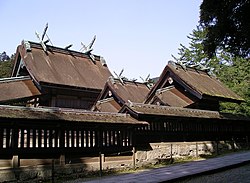Izumo, Shimane
|
Izumo 出雲市 |
||
|---|---|---|
| City | ||

Izumo Taisha
|
||
|
||
 Location of Izumo in Shimane Prefecture |
||
| Location in Japan | ||
| Coordinates: 35°22′N 132°46′E / 35.367°N 132.767°ECoordinates: 35°22′N 132°46′E / 35.367°N 132.767°E | ||
| Country | Japan | |
| Region | Chūgoku (San'in) | |
| Prefecture | Shimane Prefecture | |
| Government | ||
| • Mayor | Hideto Nagaoka | |
| Area | ||
| • Total | 543.48 km2 (209.84 sq mi) | |
| Population (March 2010) | ||
| • Total | 145,008 | |
| • Density | 270/km2 (690/sq mi) | |
| Symbols | ||
| • Tree | Japanese Black Pine | |
| • Flower | Chrysanthemum | |
| Time zone | Japan Standard Time (UTC+9) | |
| City hall address | 109-1 Imaichichō, Izumo-shi, Shimane-ken 693-8530 |
|
| Website | www |
|
Izumo (出雲市 Izumo-shi?) is a city in Shimane Prefecture, Japan. Izumo is known for Izumo soba noodles and the Izumo Taisha Shinto shrine.
The Grand Shrine (Izumo Taisha) is the oldest Shinto shrine in Japan. In 2008, the holy area was open to the public from 1 August until August 17, after which extensive renovation work began. The nearby Shimane Museum of Ancient Izumo, also located in Taisha Machi, has artifacts from the site.
In 2009, a team of archaeologists announced that they likely discovered—at the Sunabara Remains in Taki-chō, Izumo City—the oldest stone tools ever found in Japan. The find totaled about 20 tools dating back an estimated 120,000 years: about 80,000 years earlier than previous estimates of when the first humans arrived in the Japanese archipelago. The stones were found directly across Route 9 from Kirara Taki beach on the Sea of Japan. The excavation team was led by Doshisha University professor Kazuto Matsufuji, and the first of the tools were unearthed by Toshiro Naruse, a professor emeritus at Hyogo University of Teacher Education.
In Izumo, there are various tombs and temples, including an ancient cluster of tombs to the south of the station. Within this tomb cluster is located the largest Tumulus style tomb within the Izumo region. With an overall length of 100 metres and mound 6 metres in height, the tomb located behind the Dainenji Temple is believed to have been constructed in the 6th century with highly sophisticated construction methods for the time.
The Takase River is a canal that runs through the center of Izumo. Beginning at the Hiikawa River, the canal runs directly across the town. Constructed by developer Okaji Shichibei in 1670, the Takase was the first canal ever constructed in the then-Matsue domain. Before Okaji began his agricultural developments, the Izumo area was infertile and unable to support crops. Thanks to Okaji's developments, the area became an important region for the growing of rice and grain in the Matsue area.
...
Wikipedia


